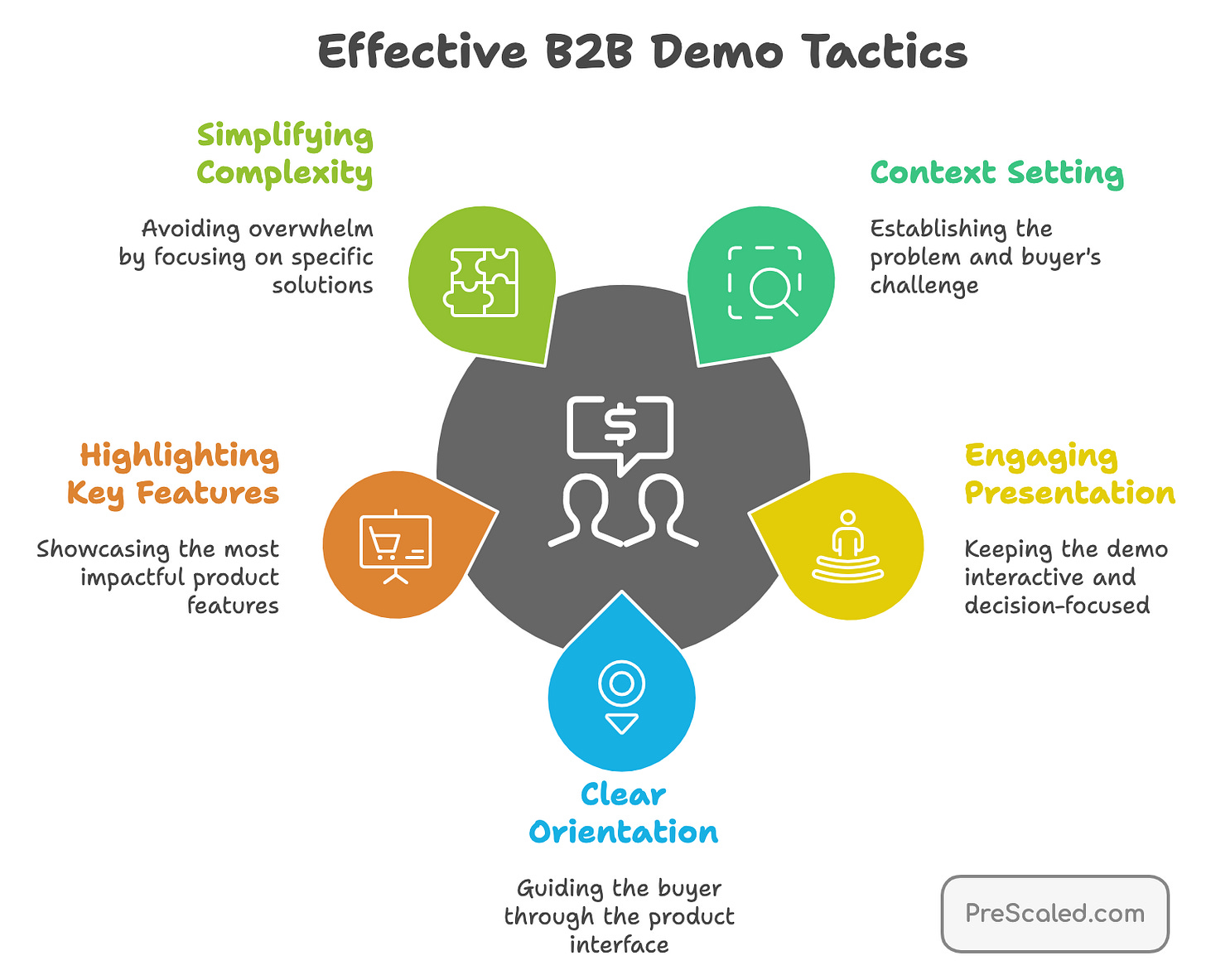Hi 👋 It’s Dmitri, and welcome to Point-Blank, my weekly practical advice and perspective on startup operations. Subscribe with other founders and operators.
Now, let's get to the point.
How to Demo B2B Products
You can't sell a B2B product without a demo. But, running a demo is a skill that requires thoughtful tactics to drive sales. I created this cheat sheet to help with that. Here are the 5 Don'ts and Do's of a B2B demo:
Before the demo
Don’t skip the context. Jumping right into your product's awesome features without explaining why they matter is terrible form. The buyer will be lost or, worse, disinterested. So, first, frame the problem and summarize the buyer's challenge. Then, validate their experience, saying, "Based on what you've shared, this is going to be exactly what you need."
Don’t treat the demo like a lecture or a TED Talk. If you’re just informing or educating without a clear next step, you’ll leave your buyer nodding politely, not taking action. So, discuss the specific decision your buyer needs to make before starting the demo. Then, conduct the demo in a way that helps them make that decision about the next step, "My aim is to spark enough interest in what we do so that by the end, you're ready to connect us with your C-level team — or let me know if it’s not a fit. Sound good?”
During the demo
Don’t assume they know what they’re looking at. Screens filled with dashboards, widgets, and charts can feel overwhelming without being contextualized. If they’re confused about the basics, the details won’t matter, and they will be mentally checked out. So, orient them to the screen and explain what they're seeing. Confusion defaults to "no".
Don’t bury the lead. Starting with less impactful features risks losing your buyer's attention. If you save the best for last, they might not stick around long enough to see it. Grab their excitement early and show the most powerful features early. Those are the ones that customers value the most.
Don’t overcomplicate with extra features (setups, integrations, workflows). Trying to show everything your product can do will confuse and overwhelm the buyers. Focus on solving their specific problem. Overwhelmed minds hesitate, and hesitation delays decisions. To speed up, solve their pain points exactly at a 1:1 ratio. No more, no less.
At the end of the demo, wrap it up by returning to #1 and summarize the solution to their problem and current pain points. Then, close it! ✊
Writing Good Well
Writing well is one of the most underrated superpowers. Here are some lines I try to stay in between (in no particular order):
Shorten first, edit later. Write concisely, then delete unnecessary parts to avoid editing them.
There are no rules that you can't invent words, but explain them if needed.
The starting point doesn't matter. Start anywhere, then write up (beginning/introduction) or down (ending/conclusion).
Don't rely on jargon to be clear. It almost never helps, but simpler sentences do.
Exceptional copywriters can make a product or a company. Bad ones may break them.
Don't be afraid to write boldly and to own your style and intention.
Once you're done, wait 15 minutes and reread it. Edit, and then you'll be done. If you're angry, wait a day.
Writing always helps you think and distill what's essential.
All readers will note your aesthetic; only some will be impressed, and fewer will remember.
NPS is not for startups
Most customer surveys are optimized for tabulation, not insights. They squeeze all the nutrients and anecdotes out of the feedback. Leaving only ultra-processed stats junk behind that's barely suitable for that quarterly report that nobody will read (let alone learn anything from).
This applies directly to NPS metrics. It is never to be used, especially for early-stage startups. NPS is always arbitrary and, as a result, you will never connect it to the changes you're making in the product.
And I will never understand how answering "How satisfied are you with the registration process?" with a 4, 7 or 5 helps anyone inside the company. Or when you aggregate at 7.9 - what does that specifically mean?
I am a massive fan of Jason's and David's REWORK podcast, the source of the video. Its value for early-stage startups is extreme. Find it at ReWork Podcast.
You Cannot Miss PMF
Mom, look - I made a meme!
Product-market fit is a complex beast, but one thing is sure: you'll know. You cannot miss it, nor can you ignore it.
And that's the point.
If you're a founder of an early-stage startup and could use some hands-on help, find me at PreScaled.com or reply to this Point-Blank.
Thank you for reading Point-Blank. I hope you found it valuable.
Point-Blank is free, so the best way to say thanks is to share it with your social following or forward it to a pal. It only takes 16 seconds. Making this one took 11ya,696 seconds. And if you are a new round here, join!
Until next week, stay on point!
- Dmitri
P.S. I genuinely want to get to know my readers. So, please let me know what you think about Point-Blank. I'd be grateful for any type of feedback (just hit reply or comment), and I promise to respond.






